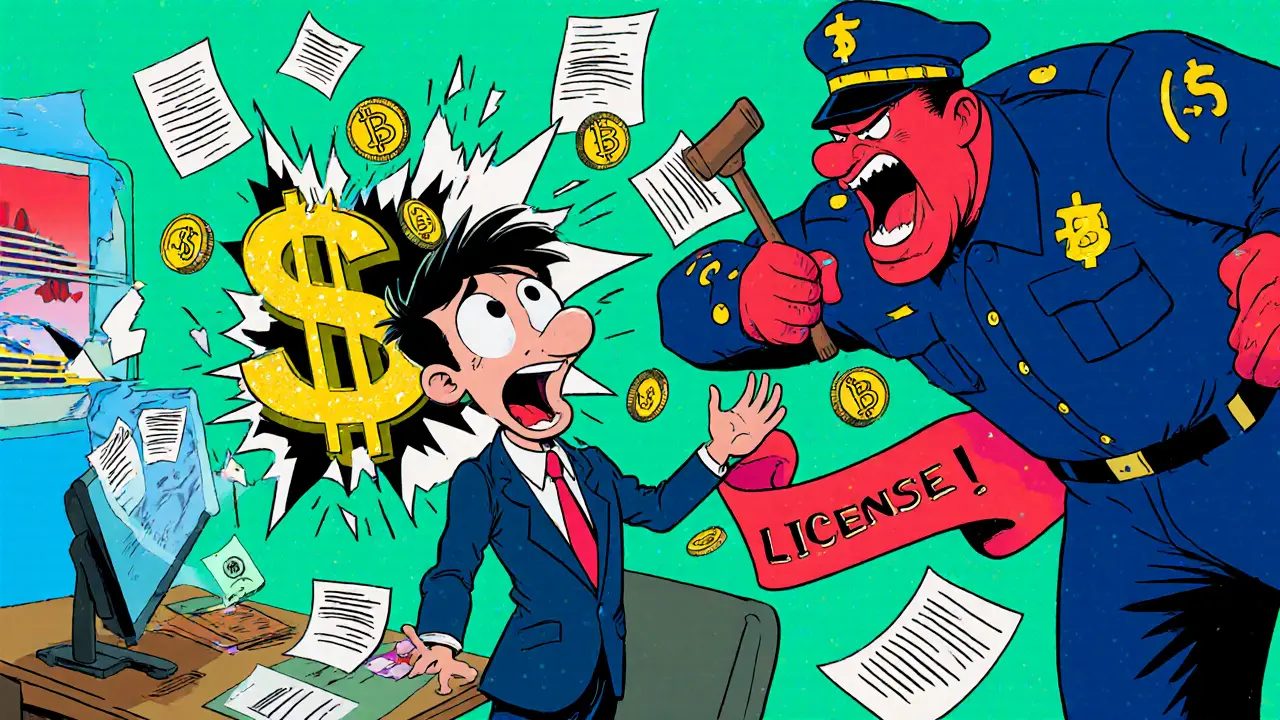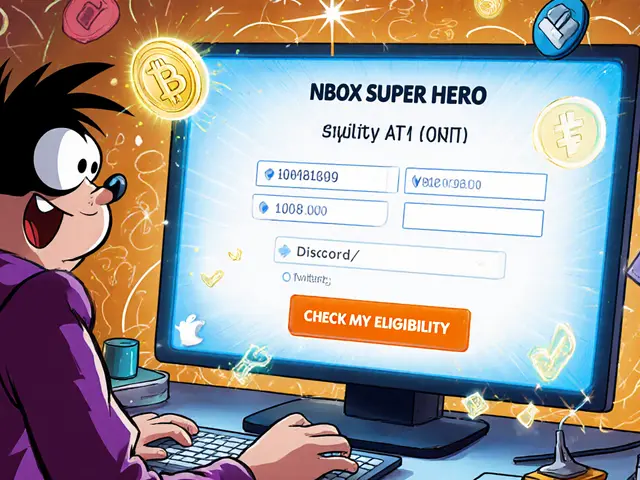
Compliance Penalty Estimator
Calculate Your Penalty Risk
Estimate potential financial and operational penalties for operating without proper blockchain licensing based on your specific circumstances.
Select the business model that most closely matches your operations
Choose the type of regulatory violation that applies to your situation
Select the primary jurisdiction where your business operates
Estimate your business scale to adjust penalty calculations
Running a crypto project without the right licenses might sound like a shortcut, but it’s a fast track to fines, lawsuits, and a ruined reputation. In the booming world of blockchain, regulators are catching up and the cost of non‑compliance is soaring. Below we unpack what licensing really means for blockchain ventures, the penalties you face when you ignore it, and a practical roadmap to stay on the right side of the law.
Why Licensing Matters in the Blockchain Space
Licensing isn’t just a bureaucratic hurdle; it’s the guardrail that protects investors, users, and the broader financial system. When a token sale or DeFi protocol operates without oversight, the chances of fraud, money‑laundering, and market manipulation skyrocket. Regulators such as the U.S. Securities and Exchange Commission (SEC) is the primary body enforcing securities laws on digital assets in the United States treat many token offerings as securities, meaning they must be registered or qualify for an exemption. Failure to do so can trigger civil enforcement actions, disgorgement of proceeds, and even criminal charges.
Core Licensing Requirements for Crypto Projects
Unlike a coffee shop that needs a health permit and a business license, a blockchain venture typically juggles several overlapping regimes:
- Securities registration: If your token promises profits based on the efforts of a team, the SEC may deem it a security. Registration on the EDGAR system or reliance on a Regulation D exemption is required.
- Money‑transmitter licensing: Platforms that move fiat to crypto (or vice‑versa) often fall under state money‑transmitter statutes. New York’s BitLicense is a classic example.
- Anti‑money‑laundering (AML) compliance: FinCEN (Financial Crimes Enforcement Network) mandates Know Your Customer (KYC) and transaction monitoring for crypto exchanges and wallet providers. Non‑compliance can lead to a civil monetary penalty of up to $1 million per violation.
- Consumer‑data privacy: The EU’s MiCA framework and the California Consumer Privacy Act (CCPA) impose data‑handling rules for blockchain services that collect personal data.
- Derivatives and lending rules: The CFTC (Commodity Futures Trading Commission) oversees DeFi lending platforms that create synthetic exposure to assets, requiring registration as a designated contract market or swap execution facility.
Each regulator defines its own set of documents, fees, and timelines - a reality that mirrors traditional business licensing but with far more technical nuance.
Consequences of Ignoring Licenses
The penalties for operating without a proper license are not uniform. They range from modest civil fines to multi‑million-dollar settlements and jail time. Here are the most common outcomes:
- SEC civil enforcement: The commission can seek disgorgement of all ill‑gotten profits, impose a civil penalty up to three times the amount of illicit gains, and bar individuals from serving as officers.
- Criminal charges: Willful evasion of securities registration can be prosecuted under the Securities Act of 1933, leading to up to five years in prison for each violation.
- State money‑transmitter fines: New York’s Department of Financial Services levied $5 million against a crypto exchange for operating without a BitLicense in 2022.
- FinCEN civil monetary penalties: Up to $1 million per violation for willful failure to implement AML controls.
- Operational shutdowns: Courts can issue injunctions that force a platform offline, effectively freezing user assets.
Real‑world cases illustrate the stakes. In 2023, a DeFi lending protocol that never registered with the CFTC was shut down, its founders fined $12 million, and the platform’s token value collapsed by 95%. Another unregistered ICO raised $24 million before the SEC halted the sale and demanded full repayment to investors.

Traditional Business vs. Blockchain Licensing Penalties
| Aspect | Traditional Business | Blockchain Project |
|---|---|---|
| Typical Penalty Range | $500‑$15,000 per violation (civil) | $5 million‑$100 million (civil) or criminal charges |
| Potential Criminal Liability | Rare, usually for fraud | Common for securities violations, up to 5 years prison |
| Business Continuity Impact | Fines, possible license suspension | Injunctions, platform shutdown, asset freeze |
| Enforcement Agency | City/County licensing bureaus | SEC, CFTC, FinCEN, state financial regulators |
| Compliance Cost (annual) | $500‑$7,000 | $10,000‑$250,000 (legal, consulting, tech solutions) |
The table shows why blockchain founders treat licensing as a strategic priority rather than an after‑thought.
Step‑by‑Step Checklist for Getting Licensed
- Identify the regulatory classification of your token or service (security, commodity, money transmitter, etc.).
- Map the jurisdictions where you will offer services. Remember that each U.S. state can have its own money‑transmitter rule.
- Engage a qualified lawyer experienced in crypto compliance. Early legal input saves millions later.
- Prepare required documentation:
- Business formation papers
- Whitepaper with disclosed risk factors
- AML/KYC policies and technology stack
- Financial statements and source‑of‑funds declarations
- Submit applications through the appropriate portals (e.g., SEC’s EDGAR, state financial services departments, FinCEN’s BSA filing system).
- Implement ongoing compliance monitoring: transaction reporting, periodic audits, and updates to regulatory changes.
- Consider compliance‑automation platforms like Mosey a software service that streamlines multi‑jurisdiction licensing for businesses. They can reduce violation risk by up to 76% according to the SBA 2023 report.
Following this roadmap transforms licensing from a gamble into a predictable cost of doing business.

Real‑World Cases of Unlicensed Blockchain Operations
Case 1: Unregistered ICO - In 2022, a startup raised $30 million via an ICO without filing a Form D. The SEC filed an administrative proceeding, ordered a $24 million disgorgement, and barred the founders from future securities offerings for three years.
Case 2: DeFi Lending Platform - The platform offered synthetic exposure to US equities without CFTC registration. After a whistleblower report, the CFTC imposed a $12 million civil fine and required the platform to cease all US‑based lending activities.
Case 3: Crypto Exchange without BitLicense - Operating in New York, the exchange ignored NYDFS’s BitLicense requirement. NYDFS levied a $5 million penalty, mandated a 30‑day shutdown, and required the company to submit a remediation plan.
These examples underscore that regulators are willing to take swift, high‑stakes actions when licensing gaps appear.
Emerging Trends Shaping the Licensing Landscape
Regulators are not standing still. The Digital Driver’s License Framework being rolled out across 35 states illustrates how digital identity verification can be tied to licensing systems-an idea that the SEC is exploring for crypto custodians. By 2026, AI‑driven compliance monitoring is expected to cut licensing violations by nearly half, according to Gartner. Moreover, the European Union’s Markets in Crypto‑Assets (MiCA) regulation will create a unified licensing regime for crypto‑asset service providers, simplifying cross‑border compliance for firms that already hold a license in one member state.
For blockchain projects, staying ahead means investing in technology that can adapt to new reporting standards, such as on‑chain analytics tools that automatically flag suspicious transactions and generate required SAR (Suspicious Activity Report) filings.
Bottom Line
If you’re building anything that moves value-tokens, stablecoins, DeFi loans, or a crypto exchange-treat licensing as a core product feature, not an afterthought. The cost of compliance is dwarfed by the potential loss of millions, the damage to brand trust, and the risk of criminal prosecution.
Do all crypto tokens need SEC registration?
No. Only tokens that meet the Howey Test-meaning they are offered as investments based on the efforts of others-are treated as securities. Utility tokens that simply grant access to a product can avoid registration, but the line is blurry and often decided case‑by‑case.
What is a BitLicense and why does it matter?
A BitLicense is New York State’s specific money‑transmitter license for virtual currency businesses. It mandates robust AML/KYC, cybersecurity, and consumer protection standards. Operating without it in New York can trigger multi‑million‑dollar fines and a forced shutdown.
Can compliance software replace a lawyer?
Software like Mosey streamlines data collection and tracks jurisdictional changes, but it can’t provide legal opinions. A qualified attorney is still essential for interpreting statutes and drafting disclosures.
What are the penalties for unlicensed DeFi lending?
Regulators view unregistered lending as offering securities or derivatives. Penalties can include civil fines up to $12 million per violation, disgorgement of profits, and criminal charges that carry up to five years imprisonment.
How does the EU’s MiCA affect US‑based crypto firms?
If a US firm offers services to EU residents, it must obtain a MiCA license or rely on a passported EU license. Failure to comply can block market access and result in fines of up to €10 million or 2 % of annual turnover.





